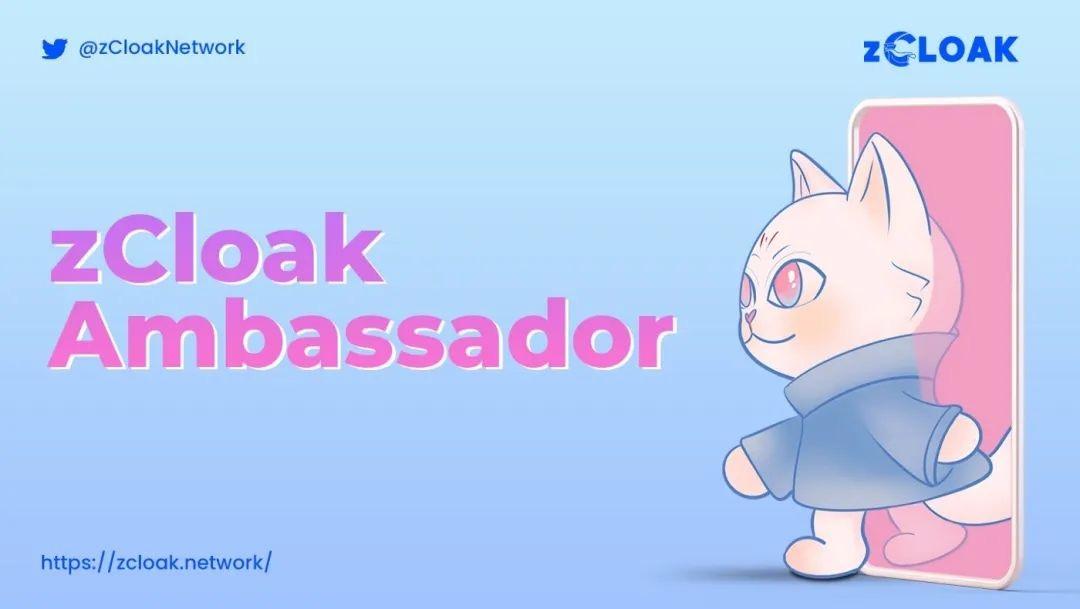zCloak Network: A New Force in Privacy Computing Emerging from Browser Plugins
Written by: Beichen, Chain Teahouse
The "usable yet invisible" functionality of privacy computing is still seen as black technology of the future in the eyes of the public, but the privacy computing track exploded in 2020, carrying high hopes for reconstructing the data world. However, to this day, there have not been a batch of visible or even perceivable landing cases in the privacy computing track.
zCloak has shown us this possibility, as it can solve our most common data privacy issues with just a browser plugin.
In this issue, we invited Xiao Zhang, the founder of zCloak Network, to help us examine the future of the privacy computing track from the perspective of lightweight products.
1. When did the team decide to create zCloak? What judgments were made at that time to reach this decision?
I recognized the vision of Web3 very much when I served as the Chinese ambassador for Polkadot in 2019—returning data sovereignty to users. The problem with the cloud computing and big data model of Web2 is that user data and the computation of that data are stored in institutional databases. If the institution commits wrongdoing or is attacked by hackers, the data can be leaked. However, at that time, the vision of Web3 did not address how users would use their data.
We believe that fundamentally protecting user privacy requires not only allowing users to control their own data but also conducting computations and analyses on that data in the users' hands (rather than on third-party servers).
Thus, the original intention of zCloak is to allow users to have complete control over their data.

2. Specifically, in what scenarios can zCloak address the pain points of privacy protection?
zCloak provides a complete set of services to utilize off-chain private data, allowing users to use this data for various analyses and computations without sending their data externally, thereby proving themselves.
For example, personal biometric information (fingerprints, iris, DNA) can be used for identity verification while protecting privacy. Additionally, there are many financial scenarios such as lending, insurance, and receipts. In short, many data usage scenarios based on privacy protection can be realized through zCloak.
3. How can you explain the technology solution called "verifiable computation in user device," which zCloak has introduced, in simple terms?
Our technology solution is "verifiable computation in user device," which means performing verifiable computation on the user side—users store their data locally, and the computations on that data are also performed on the user side.
We can abstract the computation into two core elements: one is the algorithm, and the other is the input data. From the perspective of computational science, to prove the authenticity of the computation result (output data), one must prove that the data itself is trustworthy (input data) and ensure the authenticity and reliability of the computation process.
For input data, zCloak uses DID + verifiable digital credentials to ensure its authenticity. For the computation process, it uses zero-knowledge proof technology to prove its integrity. Specifically, it employs a zk-STARK-based zero-knowledge proof virtual machine to demonstrate the authenticity and reliability of the computation process. This process may sound a bit complex, but for users, it is an atomic process that can be completed in one step. Thus, users only need to present a computation proof of local data without having to disclose their private data.
It is important to emphasize that zCloak does not directly use traditional zero-knowledge proof technology for verifiable computation on local data but rather does this based on a zero-knowledge proof virtual machine (ZKVM).
Specifically, if a third-party institution wants to verify a user's data, the user needs to perform the computation locally. The institution will first send the algorithm to the user in the form of a plain text zk-program. After the user downloads it locally, they will perform zero-knowledge proof computation in the zCloak plugin. The computation result will be sent to a third-party verifier, who only needs to check the zero-knowledge proof to determine whether the computation is correct.
The advantage of ZKVM is that the types of computations are more flexible than directly using proof circuits, allowing it to adapt to more scenarios, although there may be some compromise in efficiency.
4. There are many giants in the privacy computing track, most of which exist in the form of public chains. Why did zCloak choose to provide privacy protection based on a browser extension? Are there technical advantages or disadvantages between the two?
There are two main tracks for privacy computing in the crypto world—transaction privacy and data privacy.
Privacy public chains serve more for transaction privacy, while zCloak focuses on data privacy. Because the computation of identity data rarely involves complex algorithms like elliptic curve signatures, the computation time is much shorter (for example, our actual measurement shows that identity data verification can be completed in just one second).
Of course, zCloak's local privacy computing is different from many privacy computing platforms based on public chains/consortium chains. The distinction lies in the fact that they tend to lean towards institutional applications, where user data still resides in the databases of institutions (such as banks). zCloak aligns more with the vision of Web3, which is to return data to the users themselves, serving as the starting point for all subsequent steps.
Additionally, zCloak has more than just a browser plugin; it has components related to local privacy computing from the protocol layer to the infrastructure layer, currently consisting of three sets of components.
The first is the browser plugin zCloak ID Wallet, which is a digital identity wallet used to locally store users' digital identity data. Within the wallet, zero-knowledge proof virtual machines can be used to compute data (thus allowing work to be completed even without an internet connection).
The second is the verifier network zCloak Keeper Network, which is not yet fully decentralized, but we will gradually decentralize this network in the future. Recently, we will invite some reputable institutions or individuals to form a verifier network consisting of twenty to thirty verifier nodes, serving as independent third parties to perform zero-knowledge proof verification for users. At that time, a zero-knowledge proof will be verified simultaneously by five or six nodes, and the verification result can only be written to the on-chain smart contract after a voting process.
This leads to the third component—the zCloak on-chain smart contract, through which other projects on the chain can access the computation results of users' zero-knowledge proofs.
We believe that the future will be one of multi-chain coexistence, so we do not make any assumptions or choices about chains, and our services can be used on mainstream public chains.
5. As the privacy gateway of Web3, who are the target users of zCloak? How does zCloak reach them?
In the Web3 world, the boundary between B2B and B2C is very blurred. zCloak has many application scenarios, but during the cold start phase, it is more suitable to conduct some B2C activities in the community.
The first product of zCloak is zkID.app, which can perform local computations on user identity data within the browser plugin, allowing users to prove their identity attributes to any entity without exposing their real data to any third party. To promote zkID.app, we specifically created a mini-game based on the Warcraft background, guiding users through the entire process by creating game characters, allowing them to mint a non-transferable POAP NFT.
zkID.app also has more serious scenarios, such as collaborating with LegalDAO to establish DIDs for lawyers across multiple blockchain networks (linked to real-world legal licenses, professional experience, etc.), enabling them to provide legal services on-chain.
We will soon launch DAO Membership credentials, which are digital credentials based on cryptographic DIDs (thus not NFTs and not on-chain) that can be used to prove DAO membership and levels, and in the future, can be used for interactions between protocols or DAOs.
zCloak's recent business activities will focus on countries with stricter regulations on privacy protection. The recently launched international ambassador program received over 500 applications from around the world within about a week.
6. How will zCloak's future economic model operate?
At this stage, zCloak is positioned as a provider of privacy computing services. We provide different privacy computing services for different chains, institutions, and organizations in various scenarios, so we will charge service fees, but it doesn't necessarily have to be in the form of tokens; fiat currency is also acceptable.
The original intention of the zCloak team is to get the product operational first, and only then will we consider more complex economic models. In other words, users will use zCloak because it can genuinely solve practical problems, not because using zCloak can make money.
Of course, the zCloak verifier network involves the income of verifiers, which we are still designing. We welcome everyone to pay attention and discuss.
7. Can you introduce the current scale of the zCloak team, their past background and experience, and which areas they will focus on in the near future?
I came into contact with Bitcoin in 2011, initially studying it as a fault-tolerant distributed system. At that time, I was in the Netherlands for my master's and doctoral studies, focusing on multi-core processors and highly reliable distributed systems.
After returning to China, I had more interactions with the Ethereum Foundation in 2017 and 2018 and did some community work. In 2019, I served as one of the first Chinese ambassadors for Polkadot and have been working around the vision of Web3 within the Polkadot ecosystem, during which I met many members of the current zCloak team.
The zCloak team currently consists of 18 members, most of whom are full-time. We have also formed a dedicated cryptography team to specifically study improvements to zero-knowledge proof algorithms and applications. A significant task now is to describe zCloak's protocol in a language familiar to cryptographers and publish research papers for experts in the field of cryptography worldwide to review and recognize our design.
We have collaborations with well-known universities in China and also have partnerships overseas, such as Bobbin, the author of the zk-STARK-based virtual machine Miden, who is also our advisor.
8. Is the current progress of zCloak in line with expectations? What areas will you focus on in the near future?
The progress is relatively in line with expectations. zCloak did not conduct any market promotion before announcing the second round of financing in June. Since the announcement, the results have been quite good; the community's attention to zero-knowledge proofs, especially privacy-related projects, is very high, as it is closely related to everyone's personal interests.
In the next week or two, we will add a very significant feature to zkID, achieving a complete DID and verifiable digital credential solution that meets W3C standards. We welcome everyone to try it out when it is launched. We expect the user base of this zkID product to reach tens of thousands this year.
Additionally, we hope that at least ten protocols or projects on the B-side will use zCloak's technology to provide privacy protection for their members or clients.
9. zCloak will also support more projects to land, and privacy protection is undoubtedly a necessity in the Web2 world. What stage do you think the technological accumulation for large-scale landing has reached?
For zCloak itself, it has already reached 85%-90% progress. This year, we will refine various application scenarios for users, and by early next year, we can truly achieve large-scale commercial use, providing privacy services for ordinary users and protocols.
10. Finally, what are the potential opportunities and challenges for zCloak in the future?
The track that zCloak is in actually combines several fields, including privacy computing, DID, and zero-knowledge proofs, and under the trend of Web3, the imaginative space is very large. This track has network effects; once a solution is adopted, it can quickly spread to a very large scope, but this is a long process filled with uncertainties, so opportunities and challenges coexist.
The opportunity lies in the awakening of digital sovereignty awareness under the Web3 ideology, which is an irreversible trend, just like electric lights replacing kerosene lamps, so the market capacity will be very large.
The challenge is that we have mathematically proven that zCloak's technology can protect privacy, but convincing the market is a long process. Therefore, we need to expand zCloak's user base and usage scenarios as much as possible.










